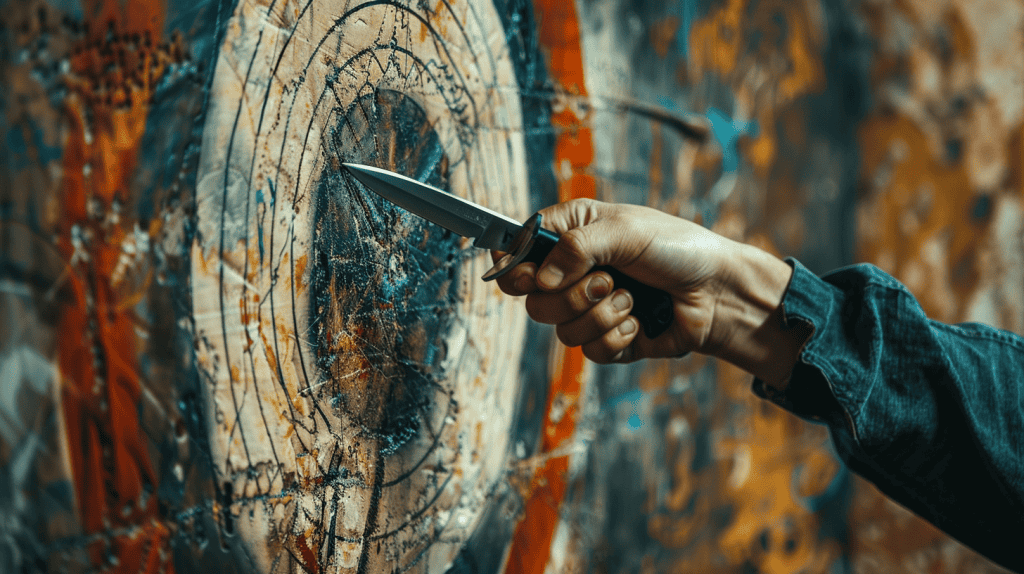When searching for a beginner’s throwing knife, focus on balance, weight, and durability. Opt for balanced or blade-heavy knives with a center of gravity near the middle or blade, making them easier to control. A knife around 12 inches and weighing 200-300 grams is ideal for starters, providing stability and ease of throwing. High-carbon or stainless steel guarantees durability, while an ergonomic handle design offers a comfortable grip. Safety features such as non-slip grips and blunt handles reduce accident risks. Renowned brands and user reviews are also valuable resources. For further success in knife throwing, understanding these elements is essential.
Key Takeaways
- Balanced knives with a center of gravity in the middle are versatile and beginner-friendly.
- Knives around 12 inches and weighing 200-250 grams offer optimal balance and control for beginners.
- High-carbon steel and stainless steel provide durability and performance consistency.
- Ergonomic handle designs with textured grips improve comfort and control.
Understanding Knife Types
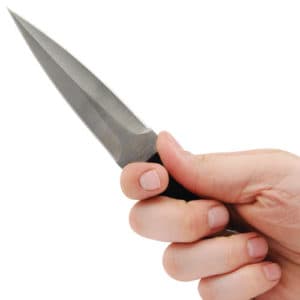 When starting with throwing knives, it’s crucial to understand the different types available. There are primarily three knife types: balanced, handle-heavy, and blade-heavy. Each type has its own set of characteristics that can affect your throwing techniques.
When starting with throwing knives, it’s crucial to understand the different types available. There are primarily three knife types: balanced, handle-heavy, and blade-heavy. Each type has its own set of characteristics that can affect your throwing techniques.
Balanced knives have their center of gravity in the middle, making them versatile and easier for beginners to control. They allow you to throw from both the handle and the blade, which can help you develop a more well-rounded skill set.
Handle-heavy knives, with their weight concentrated towards the handle, are typically thrown by gripping the blade. This type might require more practice but can offer more control once you get the hang of it.
Blade-heavy knives, on the other hand, have their center of gravity near the blade, making them ideal for throwing from the handle. These are often recommended for beginners because they stick to the target more reliably.
Understanding these knife types will allow you to choose the one that best fits your throwing style, improving your accuracy and consistency. Mastering the nuances of each type will also better equip you to refine your throwing techniques and achieve excellent results.
Ideal Weight and Size
Choosing the ideal weight and size for your throwing knives is essential for developing proper technique and accuracy. As a beginner, you’ll want to find a balance that suits your throwing techniques and grip styles.
Generally, novices are recommended to buy a knife around 12 inches long and weighing 200 to 250 grams. This range offers a good mix of stability and ease of handling, allowing you to focus on honing your skills.
Several factors should be considered when selecting the right knife:
- Grip Comfort: Verify the knife fits comfortably in your hand, supporting various grip styles.
- Material Durability: Opt for stainless steel or high-carbon steel for longevity and consistent performance.
- Blade Thickness: Thicker blades often offer better durability but may require more force to throw accurately.
- Handle Design: Consider a handle that allows for a secure grip without causing discomfort over prolonged use.
Balance and Distribution
Understanding balance and distribution is essential for effective knife throwing.
You’ll want to focus on the knife’s center of gravity, ensuring weight is evenly distributed for a stable flight.
Symmetrical designs often provide better control and accuracy, making them ideal for beginners.
Center of Gravity
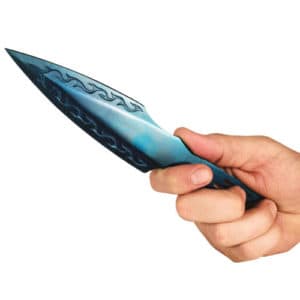 To master throwing knives, you must understand how the center of gravity affects balance and distribution. The center of gravity is essential because it influences how the knife travels through the air, impacting your throwing techniques and target practice success. A well-balanced knife will have a center of gravity near its midpoint, making it easier to control and predict its trajectory.
To master throwing knives, you must understand how the center of gravity affects balance and distribution. The center of gravity is essential because it influences how the knife travels through the air, impacting your throwing techniques and target practice success. A well-balanced knife will have a center of gravity near its midpoint, making it easier to control and predict its trajectory.
When choosing a throwing knife, consider these important factors:
- Point of Balance: A balanced knife has its center of gravity at or near the middle, aiding in consistent throws.
- Handle vs. Blade: Different throwing techniques require different balances; some may prefer a heavier blade, while others prefer a heavier handle.
- Spin Control: A balanced knife allows better control over spin, which is vital for rotational and no-spin throws.
- Material Distribution: Weight distribution affects how the knife feels in hand and its flight stability.
Research indicates that beginners benefit from knives with a balanced center of gravity, offering greater predictability and control. Understanding these principles will greatly enhance your throwing accuracy and consistency.
Weight Proportions Matter
When learning to throw knives, you’ll quickly find that weight proportions play an important role in balance and distribution. A knife’s weight directly affects how it moves through the air, which is vital for mastering various throwing techniques. If the knife is too light, it won’t have the necessary momentum, making it challenging to control. Conversely, a knife that is too heavy can be difficult to throw accurately.
Balance and weight distribution are also important when considering grip styles. Different grip styles, such as the hammer or pinch grip, require varying levels of control and stability. A well-balanced knife guarantees that the weight is evenly distributed, allowing for consistent throws regardless of your grip style. This balance helps achieve a predictable rotation and improves your accuracy over time.
Research indicates that beginners often benefit from knives weighing between 200 and 300 grams. This weight range balances control and momentum, facilitating easier mastery of basic throwing techniques. Additionally, confirm that the knife’s center of gravity is neither too forward nor too backward, as this impacts the knife’s flight path and stability.
Symmetrical Design Benefits
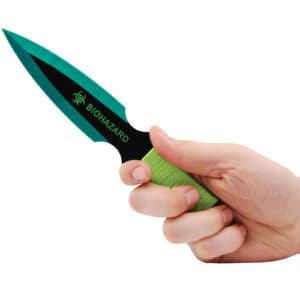 Asymmetrical design in throwing knives guarantees balanced weight distribution, making them easier to control and predict in flight. This balance is essential for beginners, as it aids both accuracy and consistency. The symmetrical advantages extend beyond mere ease of use, impacting the knife’s overall performance.
Asymmetrical design in throwing knives guarantees balanced weight distribution, making them easier to control and predict in flight. This balance is essential for beginners, as it aids both accuracy and consistency. The symmetrical advantages extend beyond mere ease of use, impacting the knife’s overall performance.
For instance, a symmetrical knife allows you to:
- Achieve uniform rotation: The knife spins evenly during flight, enhancing your ability to hit your target consistently.
- Prevent deviation: Balanced weight distribution minimizes the likelihood of the knife veering off course.
- Ensure design stability: Symmetry stabilizes the knife’s trajectory, reducing wobble and increasing precision.
- Facilitate easier learning: Beginners often find symmetrical knives simpler to master due to their predictable behavior.
Research indicates that knives with symmetrical designs typically show a 20% improvement in accuracy for novice throwers compared to asymmetrical designs. This design stability translates to fewer missed throws and a more enjoyable learning experience.
As a result, when you’re starting, opting for a symmetrical throwing knife can markedly boost your skills and confidence.
Material and Durability
When choosing throwing knives, you should consider the essential materials in performance and durability.
High-carbon steel and stainless steel are among the best blade materials, offering a balance between hardness and resistance to corrosion.
Ensuring your knife has a long-lasting build quality will save you from frequent replacements and provide consistent throwing experiences.
Optimal Blade Materials
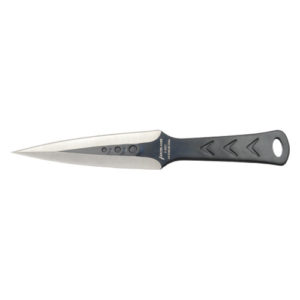 Choosing the right blade material guarantees your throwing knife‘s durability and performance. The two most common materials used in throwing knives are stainless steel and carbon steel, each offering distinct advantages.
Choosing the right blade material guarantees your throwing knife‘s durability and performance. The two most common materials used in throwing knives are stainless steel and carbon steel, each offering distinct advantages.
Stainless Steel:
Stainless steel is a popular choice due to its resistance to rust and corrosion, making it low-maintenance. This material is particularly beneficial if you plan to practice in various weather conditions. Additionally, stainless steel blades tend to have a longer lifespan, which is advantageous for beginners who may not yet have precise throwing techniques.
Carbon Steel:
On the other hand, carbon steel is known for its exceptional hardness and edge retention. This makes it a great option for those looking for a knife that stays sharp through extensive use. However, carbon steel requires more upkeep to prevent rust and corrosion, often needing regular oiling.
When selecting your first throwing knife, consider the following factors:
- Weight and Balance: Verify the knife feels comfortable in your hand.
- Blade Thickness: Thicker blades tend to be more durable.
- Edge Sharpness: Beginners might prefer a slightly blunted edge to avoid injury.
- Handle Design: Look for ergonomic designs for better grip.
Long-lasting Build Quality
Understanding the importance of material selection leads us to another critical aspect of throwing knives: long-lasting build quality. When choosing a throwing knife, you want one that withstands frequent use and impact. High-quality steel, such as 420 stainless or carbon steel, is often recommended for its strength and resistance to wear and tear. These materials undergo rigorous durability testing to verify they can handle repetitive throwing without bending or breaking.
User reviews are invaluable when evaluating the durability of a knife. Feedback from other beginners and seasoned throwers often highlights strengths and weaknesses that mightn’t be immediately apparent. Look for knives with consistently positive ratings, mentioning long-term use and minimal wear.
Additionally, consider the knife’s design elements that contribute to durability. A full-tang construction, where the blade extends through the handle, provides extra stability and reduces the risk of the knife snapping. Coatings and finishes, like black oxide, can also enhance the knife’s resistance to corrosion and scratches.
Handle Design
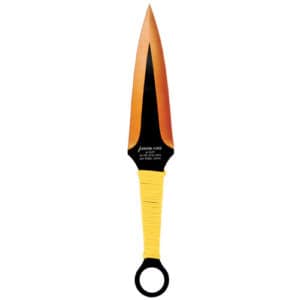 A well-designed handle can dramatically improve your accuracy and comfort when throwing knives. The handle is essential for grip comfort, ensuring the knife feels secure and balanced.
A well-designed handle can dramatically improve your accuracy and comfort when throwing knives. The handle is essential for grip comfort, ensuring the knife feels secure and balanced.
Handle materials vary widely, each offering unique benefits and drawbacks. Let’s break down what you should consider:
- Material: Common handle materials include wood, rubber, and metal. Each offers a different level of grip and durability.
- Texture: A textured handle helps maintain a firm grip, even when hands are sweaty. This is especially important for beginners who might not have perfected their throwing technique.
- Shape: The handle’s contour should fit comfortably in your hand. Ergonomically designed handles reduce strain and increase control.
- Weight: The weight of the handle affects the knife’s balance. A well-balanced knife improves your throwing accuracy.
When selecting a throwing knife, prioritize grip comfort and the specific handle materials that suit your needs. A comfortable, well-designed handle makes practice more enjoyable and helps you develop your skills more effectively.
Blade Shape and Edges
When choosing a throwing knife, consider whether a straight or curved blade suits your throwing style. Each offers different aerodynamics and control.
You’ll also need to decide between single and double edges, which influence the knife’s penetration and safety.
Balance and weight distribution are essential, affecting the knife’s flight and accuracy.
Straight Vs. Curved Blades
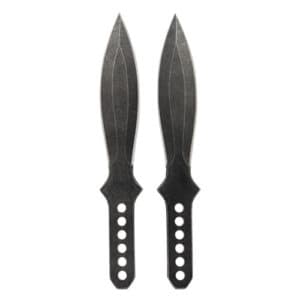 Choosing between straight and curved blades markedly impacts your throwing technique and overall accuracy.
Choosing between straight and curved blades markedly impacts your throwing technique and overall accuracy.
Straight blades offer consistent blade performance, making them ideal for beginners focusing on mastering basic throwing techniques. They tend to stick more reliably, reducing the frustration of frequent misses.
Conversely, experienced throwers often favor curved blades because they generate spin and enhance precision.
When selecting the right blade shape, consider the following factors:
- Consistency: Straight blades provide a more predictable flight path.
- Spin: Curved blades can generate more spin, which may benefit advanced techniques.
- Learning Curve: Straight blades are typically easier for beginners to handle and control.
- Application: Curved blades might suit specialized throwing styles and competitions.
Ultimately, your choice depends on your current skill level and specific goals. If you’re just starting, a straight blade can offer the consistency needed to develop your foundational skills.
Experimenting with curved blades can introduce new dimensions to your throwing repertoire as you progress.
Single Vs. Double Edges
After understanding the differences between straight and curved blades, it’s essential to contemplate whether single or double edges suit your throwing style. Single and double-edged knives each offer distinct practicalities, influencing your performance.
Single Edge Advantages: Single-edged knives are generally safer for beginners. These knives have one sharp edge and one blunt side, reducing the risk of accidental cuts when practicing. They are also easier to control, allowing you to focus on accuracy and consistency. Additionally, single-edged knives tend to be more durable, as the single-edged knife is less likely to sustain damage over time.
Double Edge Drawbacks: Double-edged knives feature two sharp edges, which can challenge beginners. They require more precision and care during handling and throwing. The increased risk of injury is a significant concern, particularly for those still developing their technique. Furthermore, due to the dual sharp edges, double-edged knives can wear out faster, necessitating more frequent maintenance.
| Feature | Single Edge | Double Edge |
|---|---|---|
| Safety | Safer due to one blunt side | Higher risk due to both sides’ sharp |
| Control | Easier to control, ideal for beginners | Requires precision, more complicated to manage |
| Durability | More durable, less likely to damage | Less durable, edges wear out faster |
Choosing between single and double edges depends largely on your skill level and comfort. For beginners, single-edged knives are typically the better choice.
Balance and Weight Distribution
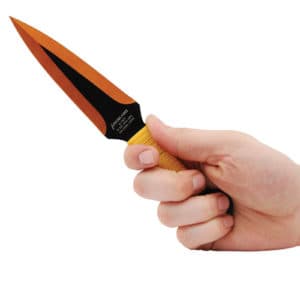 A throwing knife’s balance and weight distribution considerably impact your accuracy and overall performance. When choosing a knife, you must understand how these factors affect your throwing techniques and grip styles. A well-balanced knife will guarantee consistent throws, regardless of whether you use a hammer or pinch grip.
A throwing knife’s balance and weight distribution considerably impact your accuracy and overall performance. When choosing a knife, you must understand how these factors affect your throwing techniques and grip styles. A well-balanced knife will guarantee consistent throws, regardless of whether you use a hammer or pinch grip.
Here are key points to take into account:
- Center of Balance: A knife balanced at its midpoint offers versatility, allowing for both handle and blade throws.
- Weight: Heavier knives tend to be more stable in flight, making them ideal for beginners who are developing their throwing techniques.
- Blade Shape: Symmetrical blades provide balanced throws, while asymmetrical blades may require more skill to control.
- Edge Configuration: Single-edged knives can reduce the risk of injury during practice, whereas double-edged knives might offer better penetration.
When selecting a knife, match its balance and weight with your throwing style. A knife with a balanced design can help you refine your grip styles and improve your accuracy. Ultimately, the right knife complements your technique and aids in developing a consistent, precise throw.
Safety Features
When handling throwing knives, prioritize safety features to prevent accidents and injuries.
First, always use appropriate safety gear, such as gloves and eye protection. Gloves will protect your hands from accidental cuts while you’re perfecting your throwing techniques, and eye protection shields your eyes from potential ricochets. Additionally, consider a throwing knife with a blunt, rounded handle to reduce the risk of injury during grip adjustments.
Next, examine the knife’s design for safety enhancements. Some knives come with non-slip grips, guaranteeing a firm hold even if your hands are sweaty. This reduces the likelihood of the knife slipping during a throw. A well-designed guard or bolster can also prevent your hand from sliding onto the blade, enhancing overall safety.
Moreover, opt for knives made from durable materials, such as high-carbon steel, which are less likely to break or chip during use. Broken pieces can pose significant hazards, so investing in robust knives is vital for a safe practice environment.
Lastly, always practice safe throwing techniques. Confirm you maintain a secure, clear area free from bystanders and obstacles. Utilize a suitable target, like a wooden board, to prevent knives from bouncing back unpredictably.
Brand Reputation
Beyond focusing on safety features, it’s also essential to contemplate the brand’s reputation when choosing your throwing knives. The brand you select can greatly influence your knives’ overall quality and performance. Established brands often have a proven track record, which can be a reliable indicator of what to expect.
When evaluating brand reputation, consider the following aspects:
- Brand History: Companies with a long-standing presence in the market have typically refined their manufacturing processes over time.
- Customer Reviews: These offer firsthand insights into the experiences of other users and can highlight any common issues or praises.
- Warranty and Support: Reputable brands often provide better warranties and customer service, ensuring you’re covered if any issues arise.
- Materials and Craftsmanship: High-quality brands use superior materials and demonstrate excellent craftsmanship, improving durability and performance.
Budget Considerations
Considering your budget is essential when selecting the right throwing knives. You don’t need to break the bank to find quality knives, but understanding cost comparisons can help you make a smart purchase. Affordable options are available, and knowing what to look for guarantees you the best value for your money.
When evaluating throwing knives, you’ll notice significant price variations. Budget-friendly models can range from $20 to $40, mid-range options from $40 to $80, and high-end knives can exceed $80. Each price range offers different levels of quality, materials, and craftsmanship. Here’s a quick cost comparison to guide your decision:
| Price Range | Quality Level | Typical Features |
|---|---|---|
| $20 – $40 | Beginner-friendly | Basic designs, lower durability, simple grips |
| $40 – $80 | Intermediate | Better balance, improved materials, ergonomic designs |
| $80+ | Advanced | Superior craftsmanship, high-quality steel, enhanced balance |
Affordable options in the $20 to $40 range are perfect for beginners. They offer a decent starting point without a significant financial commitment. As you progress, consider investing in mid-range knives for better performance and durability. High-end knives, while more expensive, provide superior balance and craftsmanship, ideal for serious enthusiasts.
Maintenance Tips
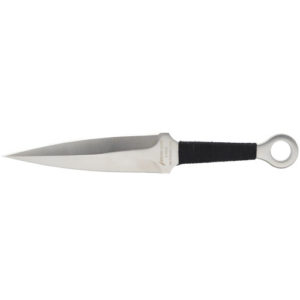 Regular maintenance guarantees your throwing knives stay sharp, balanced, and ready for action. Proper care not only extends the life of your knives but also guarantees peak performance. You need to follow specific sharpening techniques and cleaning methods to achieve this.
Regular maintenance guarantees your throwing knives stay sharp, balanced, and ready for action. Proper care not only extends the life of your knives but also guarantees peak performance. You need to follow specific sharpening techniques and cleaning methods to achieve this.
First, focus on sharpening techniques. Use a whetstone or a diamond sharpening rod to keep the blade edges keen. Maintain a consistent angle, typically between 20 to 25 degrees, to preserve the knife’s balance and effectiveness. Additionally, remember to sharpen both sides evenly to avoid any imbalance.
Cleaning methods are equally important. After each use, wipe down your knives with a damp cloth to remove dirt or residue. For a deeper clean, use mild soap and water, ensuring you dry them thoroughly to prevent rust.
Here are some practical tips:
- Sharpen regularly: Consistent sharpening keeps your knives in top condition.
- Use proper tools: Invest in quality sharpening stones or rods.
- Clean immediately: Don’t let dirt and debris sit on your knives.
- Dry thoroughly: Prevent rust and corrosion by drying knives well.


